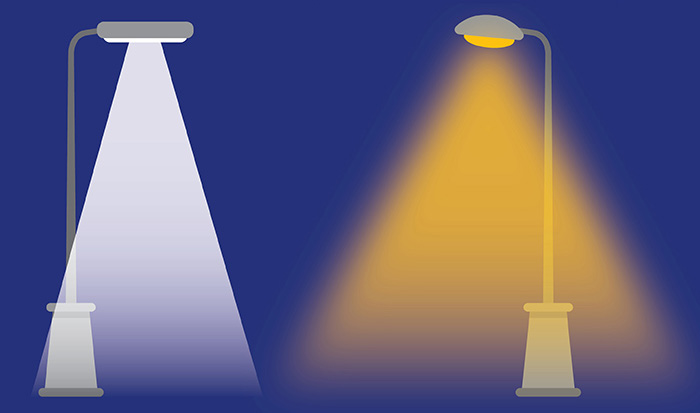Lighting Frequently Asked Questions
PPL Electric UtilitiesMore Information About Lighting
PPL Electric UtilitiesHow does an LED streetlight differ from a high-pressure sodium light?
LEDs are a whiter light with a more direct, focused coverage. High-pressure sodium are a yellow light with a less focused, wider spread.
Once a contract is signed, how long will it take for the lights to be installed?
It typically takes about 6 months for work to start once contracts are signed by all parties.What is the monthly price per light?
A municipality pays $13.216 per month for each leased 9500 lumen high-pressure sodium streetlight (covering the equipment and maintenance). The rate for an equivalent LED streetlight is $14.24 per month. The fee does not cover the cost of power to run the lights. Those charges are based on the type of lamp in the light. Since streetlights are not metered, payment is based on the average number of hours of darkness per year.
What does the SLE rate cover?
PPL’s rate represents its cost of service and the charge is approved by the state Public Utility Commission as part of our rate case. It covers the maintenance and repair of the lights and the system of wires and other equipment supporting the street light system.
Will I save money by switching to LED streetlights?
We can’t guarantee costs savings to our customers from a conversion to LED streetlights. However, savings are more likely if a customer shops for their energy supply. LED streetlights use significantly less power than high-pressure sodium (HPS) and Mercury Vapor (MV) streetlights.
Can you explain the difference between the SHS and SLE rate?
The SHS rate is for high-pressure sodium streetlights and the SLE rate is for LED streetlights. Both are the monthly lease charge per light.
Can you give me specifications for each lamp type?
| SM Rate | LUMEN Size | Lamp Watts | Total Watts * | Annual KWH ** |
|---|---|---|---|---|
|
MV |
3,350 |
100 |
137 |
589 |
|
MV |
6,650 |
175 |
214 |
920 |
|
MV |
10,500 |
250 |
299 |
1,286 |
|
MV |
20,000 |
400 |
474 |
2,038 |
|
MV |
34,000 |
700 |
808 |
3,474 |
|
MV |
51,000 |
1,000 |
1,117 |
4,801 |
High Pressure Sodium (HPS)
| SHS Rate | LUMEN Size | Lamp Watts | Total Watts * | Annual KWH ** |
|---|---|---|---|---|
|
HPS |
5,800 |
70 |
83 |
358 |
|
HPS |
9,500 |
100 |
119 |
512 |
|
HPS |
16,000 |
150 |
175 |
754 |
|
HPS |
25,500 |
250 |
316 |
1,360 |
|
HPS |
50,000 |
400 |
496 |
2,134 |
Light Emitting Diode (LED)
| SLE Rate | LUMEN Size | Fixture Watts | Total Watts * | Annual KWH ** |
|---|---|---|---|---|
|
LED |
2,600 |
36 |
36 |
155 |
|
LED |
3,300 |
50 |
50 |
228 |
|
LED |
3,800 |
53 |
53 |
226 |
|
LED |
4,900 |
70 |
70 |
312 |
|
LED |
7,500 |
91 |
91 |
398 |
|
LED |
15,000 |
170 |
170 |
742 |
|
LED |
20,000 |
269 |
269 |
1,150 |
*Total Watts includes the Lamp/Bulb and the Ballast for Mercury Vapor (MV) and High Pressure Sodium (HPS)
**Annual kWh is calculated by taking total watts then dividing by 1000 and multipling by 4300 hrs /yr
ie. HPS, 9500 Lumen, 100 Lamp : (119 Watts / 1000 k) X 4300 hrs/yr = 512 kWh/yr
How is the LED streetlight rate designed?
PPL Electric Utilities’ LED streetlight rate is designed to collect the costs the company expects to incur for the equipment, installation and other costs related to the LED streetlights and area lights.
What was the approval process for LED's and Street Lighting?
Our rates were proposed as part of our 2015 rate case and were investigated by the state Public Utility Commission. The PUC ultimately approved the prices set forth in our tariff and those charges were effective Jan. 1, 2016.
Are we obligated to convert our existing lights to LEDs?
Customers are under no obligation to convert their existing high-pressure sodium (HPS) lights to LED’s. We encourage customers to evaluate their lighting needs and select the options that best meet their community’s needs. PPL can’t speak to the pricing of other companies.
LED fixtures Kelvin Color Temperature
- LED Overhead fixtures are 4,000 Kelvin Color Temperature and,
- LED low Mount fixtures are 3,000 Kelvin Color Temperature.